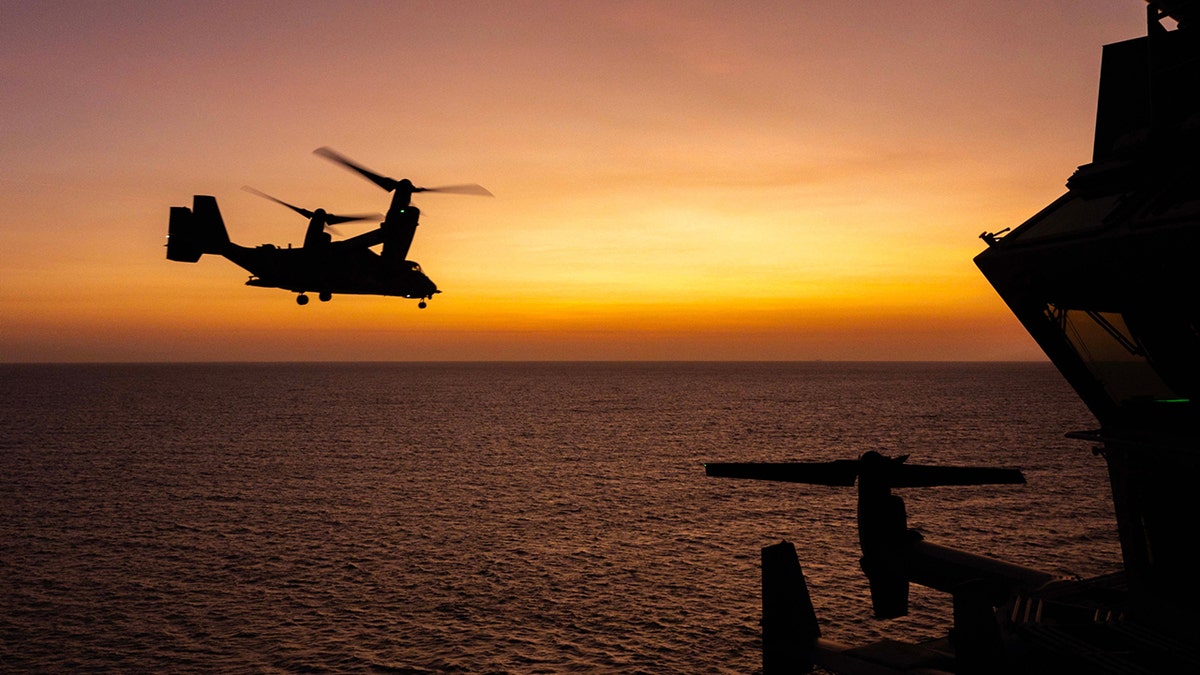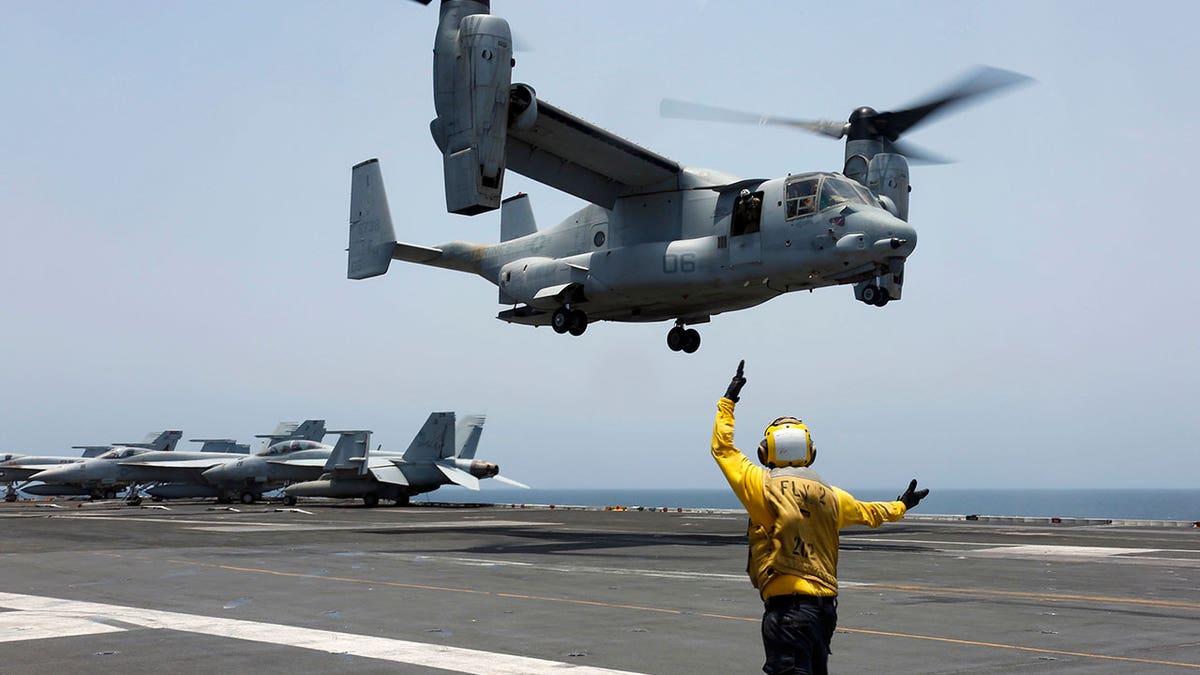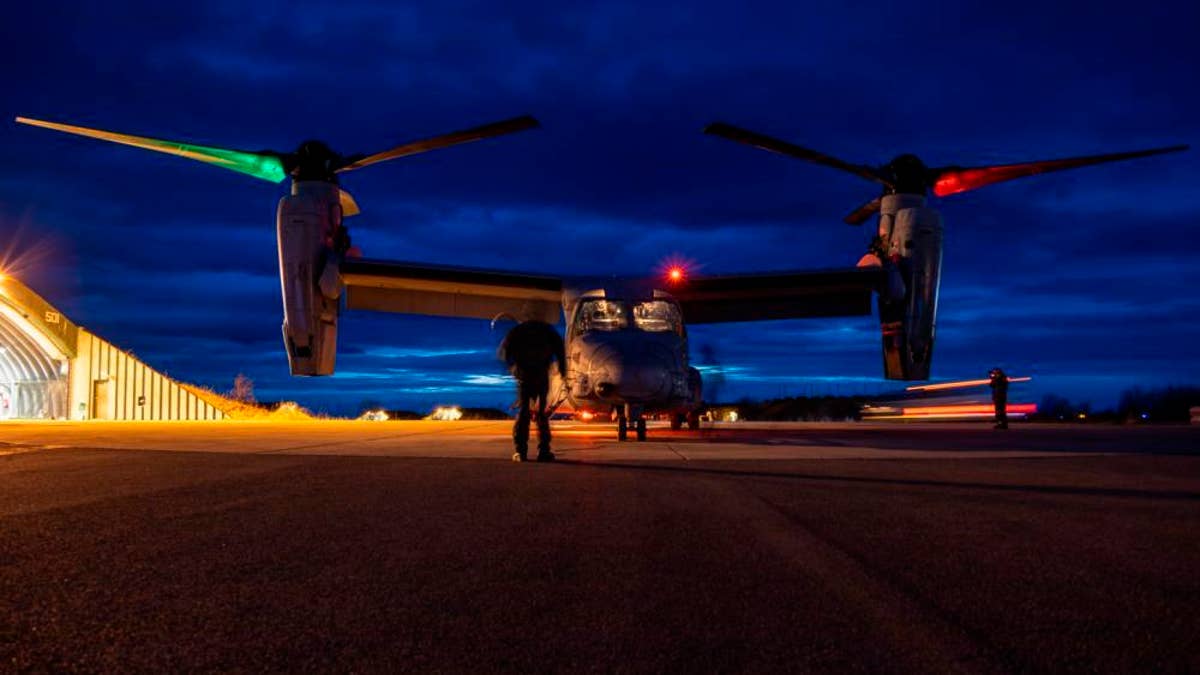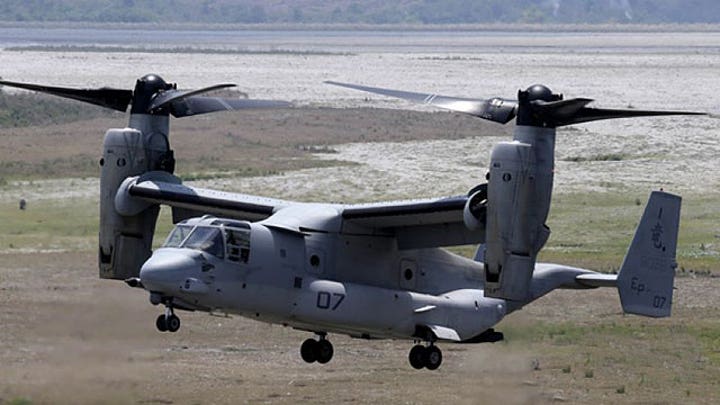Biden has to at least consider some strikes on Iranian assets or IRGC targets: Rebecca Grant
Fox News contributor Dr. Rebecca Grant discusses the U.S. striking targets in Iraq and Syria after a drone attack killed three U.S. soldiers and Houthi rebels' continued attacks in the Red Sea on 'Fox News Live.'
Last Friday, the Marines, Navy and Air Force gave the V-22 Osprey the green light to return to flying status three months after the fatal crash of an Air Force CV-22 in the seas off Japan. It was a bold decision, given that this was the fourth V-22 crash in two years.
But the simple fact is that so much depends on the one-of-a-kind Osprey: everything from secure embassy evacuations to deliveries to aircraft carriers at sea. And the Marines don’t go to war without it.
The Osprey fleet will take careful steps getting back in the air. Crews must have refresher training and implement new maintenance procedures. "There is a strong desire to return to fly because this is a capability we want to have," said Lt. Gen. Tony Bauernfeind, commander, Air Force Special Operations Command on Feb. 20.

A U.S. Marine Corps MV-22B Osprey flys past HMAS Canberra off the coast of Darwin during Indo-Pacific Endeavour 2023. (Australian Department of Defense)
The Pentagon isn’t saying exactly which mechanical part caused the Nov. 29 crash, although divers recovered the black box. Curious as I am, the secrecy is understandable. The Ospreys will fly and fight for a long time, and officials don’t want to give Chinese snoops any insights.
MY CHINESE DRONE BAN IS A BIG WIN FOR US NATIONAL SECURITY BUT CCP TECH STILL POSES MAJOR THREATS
With threats from China increasing, a new era for the Osprey is just beginning. Here’s why.
First, the advanced tiltrotor technology is spectacular
The V-22 Osprey has a fixed wing with two engines that pivot so the V-22 can fly like a plane, or hover and move like a helicopter. Admit it. You’ve never seen anything like the Osprey.
In recent years the Ospreys have flown a lot over Washington, D.C., where even jaded capital residents accustomed to presidential helicopters, Air Force One and ceremonial military aircraft fly-bys at Arlington Cemetery will look up and gawk at the Osprey.
"So epic," posted a fisherman known as the Baltimore Angler, who got video of a pair of Ospreys in hover mode low over the Potomac River, framed by fishing poles. "Flew right over the boat with their props in the up position!"
Popular Washington Post columnist Petula Dvorak described the Ospreys as alien warships with bodies as long as five-story buildings. The "massive, tilt-rotor aircraft don’t look or sound like the zippy dragonfly helicopters we’re all used to," she wrote.

An MV-22 Osprey is signaled to land on the flight deck of the USS Abraham Lincoln in the Arabian Sea on May 17, 2019. (Mass Communication Specialist 3rd Class Amber Smalley/U.S. Navy via AP, File)
The powerful engines give the Osprey a distinct low thrum. The ability to tilt them from hover to level flight is so useful because it gives the Osprey greater speed and range than a helicopter, yet with the same ability to land practically anywhere.
Hence, the Osprey is top choice for difficult rescue missions and embassy evacuations
After Hamas attacked Israel on Oct. 7, one of the Pentagon’s first moves was to put the 26th Marine Expeditionary Unit and the USS Bataan Amphibious Ready Group, with its Ospreys, on call in the Eastern Mediterranean in case the conflict boiled over.
When the fleet was grounded, the Marine Corps granted the MV-22s of the "Golden Eagles" of Marine Medium Tiltrotor Squadron (VMM) 162 a waiver to fly for "emergent operational necessity" Ospreys from amphibious ships like USS Bataan.
US MILITARY DEPLOYS NUCLEAR-POWERED SUBMARINE IN MIDDLE EAST
The Osprey’s operational record is solid
If you remember the Osprey for its rocky early history, think again. The fleet has now amassed over 600,000 flying hours.
Years ago, the Osprey raised eyebrows when it first flew in 1989. Secretary of Defense Dick Cheney famously tried and failed to kill it off. However, by 2005, changes had been made and the Osprey was in full production.
Together the Marines and Air Force special operations made the Osprey into a combat workhorse. Today there are well over 400 Ospreys in service with the Marine Corps, Air Force and Navy, and with Japan’s military, too.
As Steve Busby pointed out in a Feb. 25 article for Defense One, the 10-year average mishap rate for MV-22s is 3.43 per 100,000 flight hours, placing the mishap rate "squarely in the middle" of other current Marine Corps aircraft.
THINK THE US EXIT FROM AFGHANISTAN WAS BAD? LOOK WHAT'S BREWING IN THE PACIFIC
The Marines don’t go to war without the Osprey
Pacific theater war plans rely on the Osprey for a huge range of missions. The Marine Corps plans to use Ospreys to insert and reposition small teams of Marines on land or at sea. They call it distributed maritime operations. That's military-speak for covering a lot of distance very fast, under enemy fire if required.
Operating from multiple, shifting locations makes it harder for enemy forces to figure out what’s going on. It’s a major deterrent that keeps the foe guessing and can prevent China, for example, from concentrating forces to threaten disputed islands.
MV-22s will bring in supplies and ammo, reposition Marines, and keep the battlespace changing in ways that give the Marines the upper hand.

U.S. Marines inspect a MV-22B Osprey prior to flight at Norwegian Air Force Base Bodo during Exercise Cold Response, March 16, 2022. (Lance Cpl. Elias E. Pimentel III/U.S. Marine Corps via AP)
Navy Ospreys deliver to aircraft carriers
Need a replacement engine for the F-35 strike fighter sent to an aircraft carrier hundreds of miles offshore? That’s an Osprey mission.
CLICK HERE FOR MORE FOX NEWS OPINION
The Navy is in the midst of buying its own CMV-22s for carrier on-board delivery. These Ospreys have upgrades such as extra fuel capacity, and a secure high-frequency radio to connect with the Navy ships and aircraft more securely.
"We are better suited for long-range navigation operations, and the flexibility required to support a high-end fight in the Pacific," Capt. Sam Bryant, commander, Fleet Logistics Multi-Mission Wing, said of the CMV-22s in a 2023 interview.

An MV-22 Osprey approaches to land aboard the aircraft carrier USS Nimitz in the South China Sea on Feb. 11, 2023. (U.S. Navy photo by Mass Communication Specialist 2nd Class Justin McTaggart)
The Army wants a tiltrotor, too
The Osprey has been such a success that the Army wants a tiltrotor of their own for future vertical lift. The V-280 Valor was chosen in 2022 and while it is a V-280 new design, the Army would never have chosen an advanced tiltrotor without the strong operational record of the V-22 over the last three decades.
CLICK HERE TO GET THE FOX NEWS APP
China is green with envy
China has nothing like America’s Osprey fleet. Its United Aircraft did show off a blurry watercolor of a tiltrotor concept in February at the Singapore air show, and their state-run press routinely claims China is working on the technology, but for now China is behind. Which is good.
Each military aircraft crash is a vivid reminder of the selfless service of the men and women who fly for their country. With turbulent threats from all points of the compass, it’s important to get the Osprey back in the skies.





